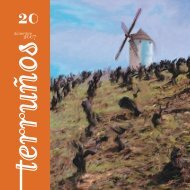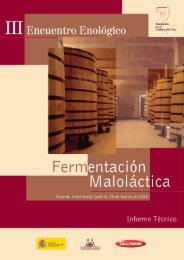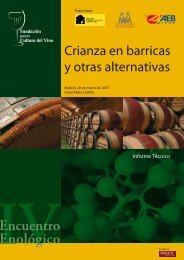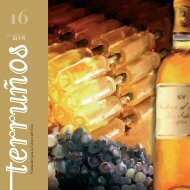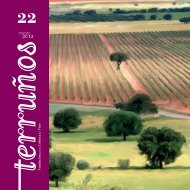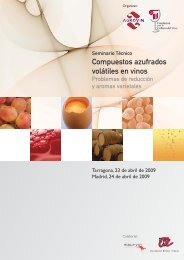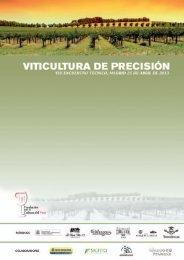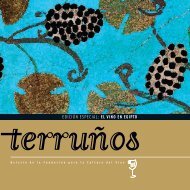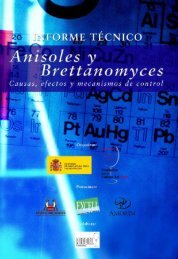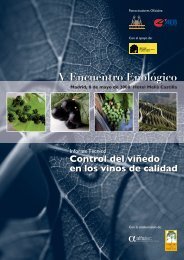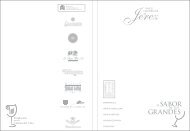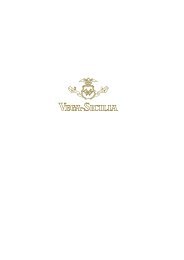Informe Técnico Gestión de pH en el vino de calidad
Informe Técnico Gestión de pH en el vino de calidad
Informe Técnico Gestión de pH en el vino de calidad
You also want an ePaper? Increase the reach of your titles
YUMPU automatically turns print PDFs into web optimized ePapers that Google loves.
7. Últimos estudios sobre intercambios aromaticos <strong>en</strong>tre ma<strong>de</strong>ra y <strong>vino</strong>composition and quality of wines with differ<strong>en</strong>t tannin cont<strong>en</strong>ts.Journal of Agricultural and Food Chemistry, 2002. 50(9): p. 2622-2626.16. SPILLMAN, P.J.I., P.G.; SEFTON,M.A., Accumulation of volatileoak compounds in a mo<strong>de</strong>l wine stored in American and Limousinbarr<strong>el</strong>s. Australian Journal of Grape and Wine Research, 1998 b. 4:p. 67-73.17. SPILLMAN, P.J., et al, Formation and <strong>de</strong>gradation of furfurylalcohol, 5-methylfurfuryl alcohol, vanillyl alcohol, and their ethylethers in barr<strong>el</strong>-aged wines. Journal of Agricultural and FoodChemistry, 1998. 46(2): p. 657-663.18. CHATONNET, P., J.N. BOIDRON, and M. PONS, Maturation of redwines in oak barr<strong>el</strong>s: evolution of some volatile compounds and theiraromatic impact. Sci<strong>en</strong>ces <strong>de</strong>s Alim<strong>en</strong>ts, 1990. 10: p. 565-587.19. PUECH, J.L. Extraction of Ph<strong>en</strong>olic Compounds from Oak Woodin Mo<strong>de</strong>l Soluctions and Evolucion of Aromatic Al<strong>de</strong>hy<strong>de</strong>s in WinesAged in Oak Barr<strong>el</strong>s. American Journal of Enolgy and Viticulture.1987, 38, 236-238.20. MAGA, J.A., Flavor contribution of wood in alcoholic beverages.Progress in Flavour Research, 1984.21. SPILLMAN, P.J., et al, Accumulation of Vanillin During Barr<strong>el</strong>-Aging of White, Red, and Mo<strong>de</strong>l Wines. Journal of Agricultural andFood Chemistry, 1997. 45(7): p. 2584-2589.22. DUBOIS, P., Apports du fut <strong>de</strong> ch<strong>en</strong>e neuf a l'arôme <strong>de</strong>s vins.Revue <strong>de</strong>s O<strong>en</strong>ologues, 1989. 120: p. 19-24.23. AZNAR, M., Jerarquización, i<strong>de</strong>ntificación y <strong>de</strong>terminacióncuantitativa <strong>de</strong> los odorantes más importantes <strong>de</strong> los <strong>vino</strong>s <strong>de</strong>crianza españoles. Construcción <strong>de</strong> mo<strong>de</strong>los quimiométricos parala predicción <strong>de</strong> los <strong>de</strong>scriptores s<strong>en</strong>soriales a partir <strong>de</strong> lacomposición química. 2002. Tesis Doctoral. Facultad <strong>de</strong> Ci<strong>en</strong>cias.Universidad <strong>de</strong> Zaragoza.24. LÓPEZ, R.F., V. HERNÁNDEZ, P; CACHO,J, I<strong>de</strong>ntification ofimpact odorants of young red wines ma<strong>de</strong> whit Merlot, CabernetSauvignon and Granche grape varieties : a comparative study.Journal of the Sci<strong>en</strong>ce of Food and Agriculture, 1999. 79: p. 1461-1467.25. ETIÉVANT, P.X., Wine. Libro "Volatile compounds in foods andbeverages ", 1991: p. 483-546.26. JARAUTA, I., Estudio analítico <strong>de</strong> f<strong>en</strong>óm<strong>en</strong>os concurr<strong>en</strong>tes <strong>en</strong> lag<strong>en</strong>eración <strong>de</strong>l aroma durante la crianza <strong>de</strong>l <strong>vino</strong> <strong>en</strong> barricas <strong>de</strong>roble con difer<strong>en</strong>tes grados <strong>de</strong> uso. Nuevos métodos <strong>de</strong> análisis <strong>de</strong>importantes aromas y caracterización <strong>de</strong> su pap<strong>el</strong> s<strong>en</strong>sorial. 2004.Tesis Doctoral. Facultad <strong>de</strong> Ci<strong>en</strong>cias. Universidad <strong>de</strong> Zaragoza.27. ORTEGA, C., et al, Fast analysis of important wine volatilecompounds: Dev<strong>el</strong>opm<strong>en</strong>t and validation of a new method basedon gas chromatographic-flame ionisation <strong>de</strong>tection analysis ofdichloromethane microextracts. Journal of Chromatography A,2001. 923(1-2): p. 205-214.28. LÓPEZ, R., et al, Determination of minor and trace volatilecompounds in wine by solid-phase extraction and gaschromatography with mass spectrometric <strong>de</strong>tection. Journal ofChromatography A, 2002. 966(1-2): p. 167-177.29. FERREIRA, V.; JARAUTA, I.; LÓPEZ, R.; CACHO, J. Quantitative<strong>de</strong>termination of sotolon, maltol, and free furaneol in wine bysolid-phase extraction and gas chromatography-ion.trap massspectrometry. Journal of Chromatography A 2003, 1010, 95-103.30. FERREIRA, V.; JARAUTA, I.; ORTEGA, L.; CACHO, J. Simplestrategy for optimization of solid-phase extraction proceduresthrough the use of solid-liquid distribution coeffici<strong>en</strong>ts.Application to the <strong>de</strong>termination of aliphatic lactones in wine.Journal of Chromatography A 2004, 1025, 147-156.31. LOPEZ, R., et al, Analysis of the aroma int<strong>en</strong>sities of volatilecompounds r<strong>el</strong>eased from mild acid hydrolysates of odourlessprecursors extracted from Tempranillo and Gr<strong>en</strong>ache grapes usinggas chromatography-olfactometry. Food Chemistry, 2004. 88(1): p.95-103.32. HANNA PELEG, M.N., URI ZEHAVI, RUSSELL L. ROUSEFF, STEVENNAGY;, Pathways of 4-vinylguaiacol formation from ferulic acid inmo<strong>de</strong>l solutions of orange juice. Journal of Agricultural and FoodChemistry, 1992. 40(5): p. 764-767.33. ROMERO, D.A., Bacteria as pot<strong>en</strong>tial sources of flavormetabolites. Food- Technology, 1992. 46(11): p. 122, 124-126.34. BERTRAND, A.R., G.; PRIPIS- NICOLAU, L, S<strong>en</strong>sory evaluation ofconsequ<strong>en</strong>ces of malolactic ferm<strong>en</strong>tation for white in barr<strong>el</strong>s.Bulletin <strong>de</strong> l´O.I.V., 2000. 73(831/832): p. 313-321.35. BRUNATI, M.M., F.: BERTOLINI, C.:GANDOLFI, R.:DAFFONCHIO, D.;MOLINARI, F, Biotransformation fo cinnamic and ferulic acid withactinomycetes. Enzyme and microbial technology, 2004. 34(1): p.3-9.36. MILLER, D.P., et al, The Cont<strong>en</strong>t of Ph<strong>en</strong>olic-Acid and Al<strong>de</strong>hy<strong>de</strong>Flavor Compon<strong>en</strong>ts of White Oak as Affected by Site and Species.American Journal of Enology and Viticulture, 1992. 43(4): p. 333-338.37. POLLNITZ, A.P., K.H. PARDON, AND M.A. SEFTON, Quantitativeanalysis of 4-ethylph<strong>en</strong>ol and 4-ethylguaiacol in red wine. Journal ofChromatography A, 2000. 874(1): p. 101-109.38. MULLER, C.J., R.E. KEPNER, and A.D. WEBB, Lactones in wines -a review. American Journal of Enology and Viticulture, 1973. 24(1):p. 5-9.39. GARDE, T., D. TORREA, and C. ANCIN, Accumulation of volatilecompounds during ageing of two red wines with differ<strong>en</strong>tcomposition. Journal of Food Engineering, 2004. 65(3): p. 349-356.40. CUTZACH, I., et al, Study in aroma of sweet natural non Muscatwines. II. Quantitative analysis of volatile compounds taking partin aroma of sweet natural wines during ageing. JournalInternational <strong>de</strong>s Sci<strong>en</strong>ces <strong>de</strong> la Vigne et du Vin, 1998. 32(4): p.211-221.41. MORENO, J.A., et al, Aroma compounds as markers of thechanges in sherry wines subjected to biological ageing. FoodControl. In Press, Corrected Proof.42. VAN GEMERT, L.J., Compilations of Odour Threshold Values inAir and Water. 2003, Bo<strong>el</strong><strong>en</strong>s Aroma Chemical Information Service.43. FERREIRA, V.L., R.: CACHO, F, Quantitative <strong>de</strong>termination of theodorants of young red wines from differ<strong>en</strong>t grape varieties.Journal of the Sci<strong>en</strong>ce of Food and Agriculture, 2000. 80: p. 1659-1667.44. GUTH, H., Quantification and s<strong>en</strong>sory studies of characterimpact odorants of differ<strong>en</strong>t white wine varieties. Journal ofAgricultural and Food Chemistry, 1997. 45(8): p. 3027-3032.45. CUTZACH, I., P. CHATONNET, and D. DUBOURDIEU, Influ<strong>en</strong>ce ofStorage-Conditions on the Formation of Some Volatile Compoundsin White Fortified Wines (Vins Doux Natur<strong>el</strong>s) During the AgingProcess. Journal of Agricultural and Food Chemistry, 2000. 48(6): p.2340-2345.46. NAKAMURA, S.C., E.A.;OUGH, C.S. and TOTSUKA, A.,Quantitative analysis of g-nonalactona in wines and its threshold<strong>de</strong>termination. Journal of Food Sci<strong>en</strong>ce, 1988. 53: p. 1243-1244.47. CULLERE, L.E., A.; CACHO, J.; FERREIRA, V.; Gas112Fundación para la Cultura <strong>de</strong>l Vino



